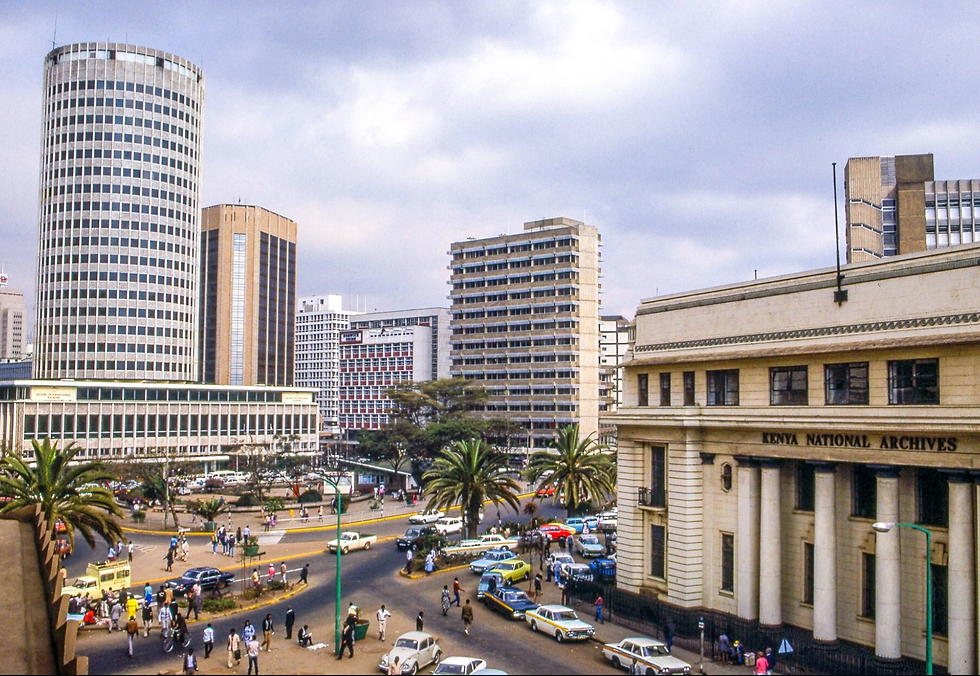NAIROBI IN MOTION: BETWEEN MEMORY AND MOMENTUM
- Samantha

- Jun 2
- 3 min read
Updated: Jun 19
Before Nairobi’s skyline claimed the horizon, it was a highland plain. Edged by cool rivers
and grazed by Maasai herders, the region was known as Enkare Nyirobi, meaning “the place
of cool waters” in Maa.

Today, Nairobi is often viewed as a gateway to the Mara or to the Coast. Always, to
something and somewhere else. Yet the city holds its own stories that are layered and often
overlooked. To understand Nairobi is to begin at the railway where empire carved its mark,
and to trace the quieter histories that ran alongside its tracks.

When in 1899 the British chose the region as a railway depot for the Uganda Railway, they
were drawn less by strategy and more by geography. It was high, temperate, and relatively
mosquito-free. Nairobi was never envisaged as a city, but a stopover. It sat in between
Mombasa (a city on Kenya’s coastline that acted as a hub for trade along the Indian Ocean)
and Kisumu (then Port Florence a city on Lake Victoria). From that single logistically led
decision, a city began to hastily rise. At the centre of it all, were its workers.

Thousands of labourers, mainly from inland Kenya and the Indian subcontinent, worked on
building the railway. The work was grueling and dangerous – we will get to the Man Eaters
of Tsavo another day. Aside from the railway workers, those who successfully navigated
colonial pass laws, formed the first of Nairobi’s working class. They filled positions within
the colonial administration and settler economy. What were pass laws, you might ask? They
were visas, before visas existed: documentation or “passes”, that authorised the movement
and presence of native Kenyans in certain areas.
Whilst Nairobi appeared as a gateway to new horizons for the colonial elite, for native
Kenyans it was the opposite. Residential segregation was strictly enforced. The city grew, but
it did so with division stitched into its layout. There were European suburbs, Asian trading
zones and native Kenyan labour quarters (known then as African labour quarters). Nairobi
was never imagined as a shared space. It was a city built on effort, but not on equity.

And yet, Nairobi endured and adapted.
As the 20th century moved forward, a new Nairobi began to stir beneath the surface. Workers
organised and students protested. The city became a quiet engine of resistance, especially
during the Mau Mau uprising which framed Kenya’s fight for independence. In its informal
settlements such as Pumwani, Ziwani, and later Mathare and Kibera, native Kenyan-led
movements for independence grew.

Then came independence in 1963. A new flag flew, but the divisions did not dissolve
overnight. Nairobi remained a city of contrasts. For every state office that rose in the city
centre, there was a swelling of unplanned slums on its fringes. With pass laws falling away,
dreams and movement surged, but the state’s delivery lagged and it struggled to keep pace
with the population’s energy. That being said, progress was made.

What emerged in the decades that followed was the birth of the hustler nation. Within
Nairobi ingenuity, improvisation, and relentless ambition ruled. When jobs were scarce,
people created them. When space was lacking, communities carved it out. Nairobi became a
place where survival was a skill and movement - be it social, economic or literal, was
everything. In spite of this, there was unwavering hope, because the people had their country
back.
Nowhere is this more visible than in the matatu: Kenya’s privately owned minibuses. They
are loud and unmistakably expressive, and far more than just transport. They are a
combination of public art, political commentary, and economic hustle rolled into one. Their
operators, often young and overlooked, exemplify the city’s entrepreneurial pulse. No
permission asked, just pure momentum.

And yet, Nairobi remains a city of deep disparity. Luxury apartments rise beside informal
settlements. Rooftop lounges overlook patchworks of corrugated iron. It is possible, here, to
have everything and nothing all at once. The language of ambition coexists with the reality of
exclusion.

To understand Nairobi is to understand tension between past and future, privilege and
perseverance, concrete and cool waters. But perhaps that is part of Nairobi’s truth: it contains
multitudes. It is neither romantic nor ruined. It is unfinished, and always will be and perhaps
that is not as terrible as it sounds. I will not fall into the trap of leaving you with an optimistic
sign off that romanticises Nairobi, just after saying the opposite. However, I will encourage
you to linger a little longer than intended, to see and experience it for yourself. Because
Nairobi has many stories to tell. It just needs more people like you, to listen.
%20(1).png)












.png)